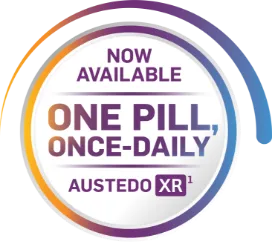For adults with TD or HD chorea1
Make a
move that
matters
With one pill, once-daily AUSTEDO XR

Rapid response. 3-year sustained results1,3-7
Response as early as Week 2.* Results through 3 years in the longest TD clinical trial to date.†‡
only with austedo xr‡Flexibility for effective & tolerable control1,2
The most once-daily doses of any VMAT2 inhibitor, including for patients taking concomitant medications metabolized through CYP3A4/5 and CYP2D6.
only with austedo xr‡Easy & convenient1,6
Convenience of an easy-to-use Titration Kit with one pill, once-daily dosing for all new patients.
Access & affordability6
~90% of patients pay $10 or less per month for AUSTEDO XR. Preferred coverage across a majority of national Medicare
Part D plans.
*Response observed as early as Week 2 in placebo-controlled studies.3,4
†Open-label extension study.5
‡Patients in the pivotal and long-term studies received the AUSTEDO BID formulation.1,5
Mechanism of Action:
VMAT2 inhibition can help regulate dopamine function.8
For more videos, visit the
YouTube page.
For more videos, visit the
YouTube page.
Voiceover:
Maintaining a balance in the level of dopamine is essential for controlled movement.
Dopamine signaling is facilitated by vesicular monoamine transporter 2, or VMAT2, which transports monoamines, including dopamine, from the cytosol into synaptic vesicles, keeping them ready for subsequent release in response to an action potential.
When an action potential reaches the nerve terminal of the presynaptic neuron, dopamine is released from the synaptic vesicles into the synaptic cleft.
This dopamine binds to receptors on the postsynaptic neuron, thereby signaling movement.
Excess dopamine signaling manifests as abnormal involuntary movements.
AUSTEDO® (deutetrabenazine) is a VMAT2 inhibitor.
Deutetrabenazine contains deuterium, a naturally occurring heavy version of hydrogen. Deuterium forms stronger molecular bonds with carbon atoms, thereby extending the half-life of therapeutic metabolites.
The precise mechanism by which deutetrabenazine exerts its effects on abnormal involuntary movements is unknown. It is believed to be related to its effect as a reversible depleter of monoamines, including dopamine, from nerve terminals.
Deutetrabenazine binds to VMAT2 on the vesicle in the presynaptic neuron and inhibits the uptake of dopamine into synaptic vesicles.
Dopamine molecules collect outside the blocked VMAT2 and are degraded by monoamine oxidase.
Reducing dopamine levels in the presynaptic neuron results in less dopamine signaling to the postsynaptic neuron.
Limiting dopamine signaling is believed to lead to fewer abnormal involuntary movements.
HD, Huntington’s disease; TD, tardive dyskinesia; VMAT2, vesicular monoamine transporter 2.
REFERENCES: 1. AUSTEDO® XR (deutetrabenazine) extended-release tablets and AUSTEDO® current Prescribing Information. Parsippany, NJ: Teva Neuroscience, Inc. 2. Ingrezza® (valbenazine) capsules. Prescribing Information. San Diego, CA: Neurocrine Biosciences, Inc. 3. Anderson KE, Stamler D, Davis MD, et al. Deutetrabenazine for treatment of involuntary movements in patients with tardive dyskinesia (AIM-TD): a double-blind, randomised, placebo-controlled, phase 3 trial. Lancet Psychiatry. 2017;4(8):595-604. 4. Fernandez HH, Factor SA, Hauser RA, et al. Randomized controlled trial of deutetrabenazine for tardive dyskinesia: the ARM-TD study. Neurology. 2017;88(21):2003-2010. 5. Hauser RA, Barkay H, Fernandez HH, et al. Long-term deutetrabenazine treatment for tardive dyskinesia is associated with sustained benefits and safety: a 3-year, open-label extension study. Front Neurol. 2022;13:773999. 6. Data on file. Parsippany, NJ: Teva Neuroscience, Inc. 7. Marder SR, Singer C, Lindenmayer J-P, et al. A phase 3, 1-year, open-label trial of valbenazine in adults with tardive dyskinesia. J Clin Psychopharmacol. 2019;39(6):620-627. 8. Solmi M, Pigato G, Kane JM, Correll CU. Treatment of tardive dyskinesia with VMAT-2 inhibitors: a systematic review and meta-analysis of randomized controlled trials. Drug Des Devel Ther. 2018;12:1215-1238.
